Xian Wei
OMGSR: You Only Need One Mid-timestep Guidance for Real-World Image Super-Resolution
Aug 11, 2025Abstract:Denoising Diffusion Probabilistic Models (DDPM) and Flow Matching (FM) generative models show promising potential for one-step Real-World Image Super-Resolution (Real-ISR). Recent one-step Real-ISR models typically inject a Low-Quality (LQ) image latent distribution at the initial timestep. However, a fundamental gap exists between the LQ image latent distribution and the Gaussian noisy latent distribution, limiting the effective utilization of generative priors. We observe that the noisy latent distribution at DDPM/FM mid-timesteps aligns more closely with the LQ image latent distribution. Based on this insight, we present One Mid-timestep Guidance Real-ISR (OMGSR), a universal framework applicable to DDPM/FM-based generative models. OMGSR injects the LQ image latent distribution at a pre-computed mid-timestep, incorporating the proposed Latent Distribution Refinement loss to alleviate the latent distribution gap. We also design the Overlap-Chunked LPIPS/GAN loss to eliminate checkerboard artifacts in image generation. Within this framework, we instantiate OMGSR for DDPM/FM-based generative models with two variants: OMGSR-S (SD-Turbo) and OMGSR-F (FLUX.1-dev). Experimental results demonstrate that OMGSR-S/F achieves balanced/excellent performance across quantitative and qualitative metrics at 512-resolution. Notably, OMGSR-F establishes overwhelming dominance in all reference metrics. We further train a 1k-resolution OMGSR-F to match the default resolution of FLUX.1-dev, which yields excellent results, especially in the details of the image generation. We also generate 2k-resolution images by the 1k-resolution OMGSR-F using our two-stage Tiled VAE & Diffusion.
NeuroLoc: Encoding Navigation Cells for 6-DOF Camera Localization
May 02, 2025
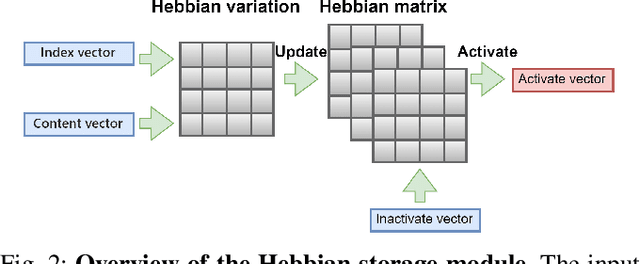
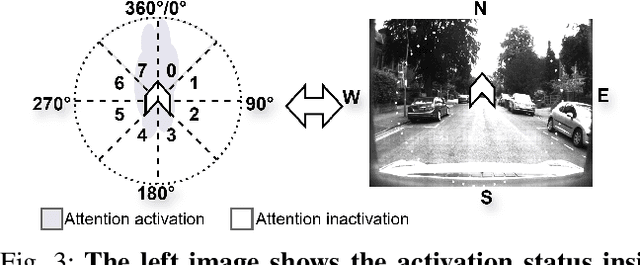
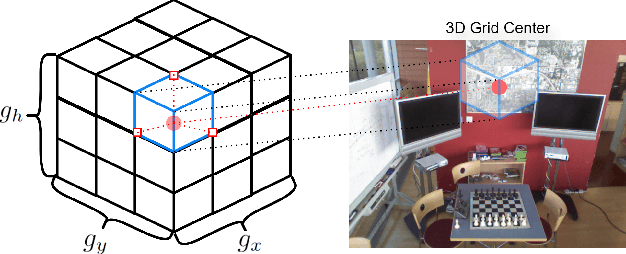
Abstract:Recently, camera localization has been widely adopted in autonomous robotic navigation due to its efficiency and convenience. However, autonomous navigation in unknown environments often suffers from scene ambiguity, environmental disturbances, and dynamic object transformation in camera localization. To address this problem, inspired by the biological brain navigation mechanism (such as grid cells, place cells, and head direction cells), we propose a novel neurobiological camera location method, namely NeuroLoc. Firstly, we designed a Hebbian learning module driven by place cells to save and replay historical information, aiming to restore the details of historical representations and solve the issue of scene fuzziness. Secondly, we utilized the head direction cell-inspired internal direction learning as multi-head attention embedding to help restore the true orientation in similar scenes. Finally, we added a 3D grid center prediction in the pose regression module to reduce the final wrong prediction. We evaluate the proposed NeuroLoc on commonly used benchmark indoor and outdoor datasets. The experimental results show that our NeuroLoc can enhance the robustness in complex environments and improve the performance of pose regression by using only a single image.
Lipschitz Constant Meets Condition Number: Learning Robust and Compact Deep Neural Networks
Mar 26, 2025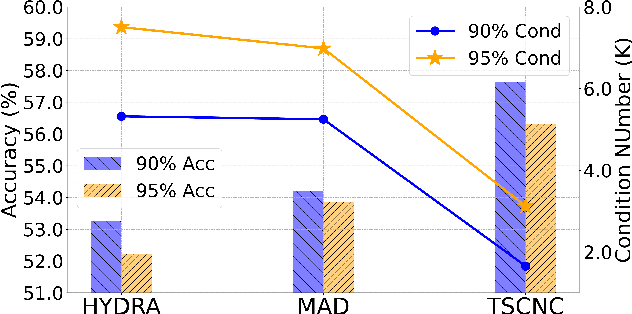


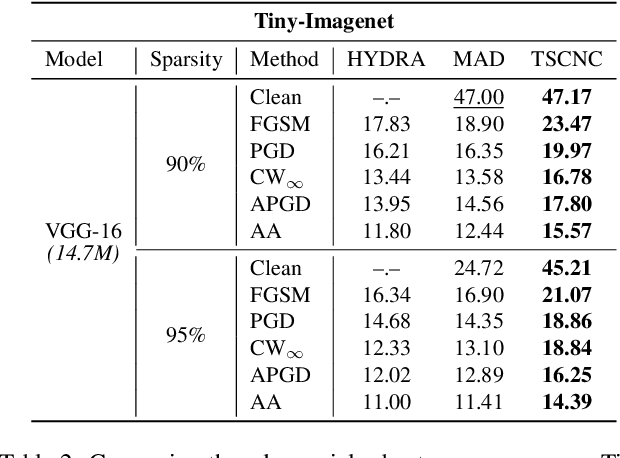
Abstract:Recent research has revealed that high compression of Deep Neural Networks (DNNs), e.g., massive pruning of the weight matrix of a DNN, leads to a severe drop in accuracy and susceptibility to adversarial attacks. Integration of network pruning into an adversarial training framework has been proposed to promote adversarial robustness. It has been observed that a highly pruned weight matrix tends to be ill-conditioned, i.e., increasing the condition number of the weight matrix. This phenomenon aggravates the vulnerability of a DNN to input noise. Although a highly pruned weight matrix is considered to be able to lower the upper bound of the local Lipschitz constant to tolerate large distortion, the ill-conditionedness of such a weight matrix results in a non-robust DNN model. To overcome this challenge, this work develops novel joint constraints to adjust the weight distribution of networks, namely, the Transformed Sparse Constraint joint with Condition Number Constraint (TSCNC), which copes with smoothing distribution and differentiable constraint functions to reduce condition number and thus avoid the ill-conditionedness of weight matrices. Furthermore, our theoretical analyses unveil the relevance between the condition number and the local Lipschitz constant of the weight matrix, namely, the sharply increasing condition number becomes the dominant factor that restricts the robustness of over-sparsified models. Extensive experiments are conducted on several public datasets, and the results show that the proposed constraints significantly improve the robustness of a DNN with high pruning rates.
KiteRunner: Language-Driven Cooperative Local-Global Navigation Policy with UAV Mapping in Outdoor Environments
Mar 11, 2025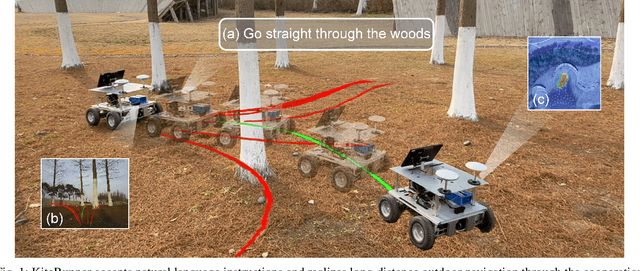
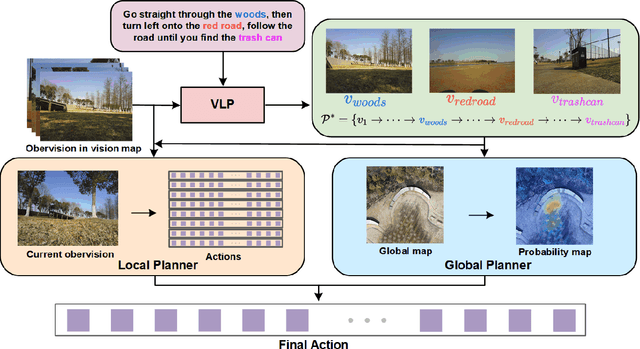
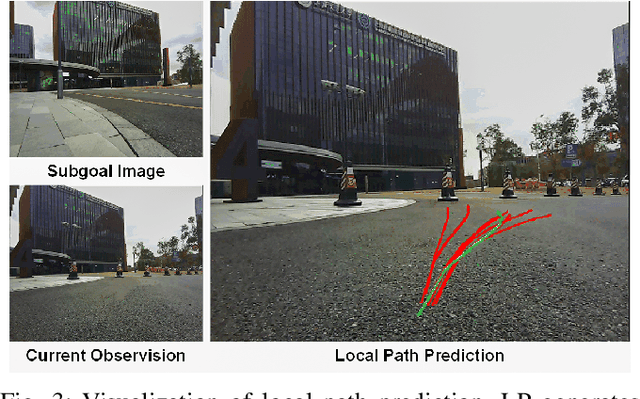
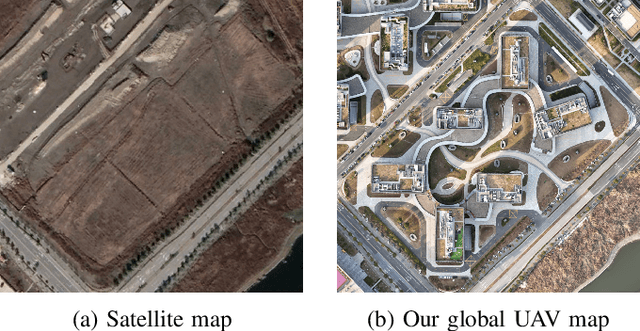
Abstract:Autonomous navigation in open-world outdoor environments faces challenges in integrating dynamic conditions, long-distance spatial reasoning, and semantic understanding. Traditional methods struggle to balance local planning, global planning, and semantic task execution, while existing large language models (LLMs) enhance semantic comprehension but lack spatial reasoning capabilities. Although diffusion models excel in local optimization, they fall short in large-scale long-distance navigation. To address these gaps, this paper proposes KiteRunner, a language-driven cooperative local-global navigation strategy that combines UAV orthophoto-based global planning with diffusion model-driven local path generation for long-distance navigation in open-world scenarios. Our method innovatively leverages real-time UAV orthophotography to construct a global probability map, providing traversability guidance for the local planner, while integrating large models like CLIP and GPT to interpret natural language instructions. Experiments demonstrate that KiteRunner achieves 5.6% and 12.8% improvements in path efficiency over state-of-the-art methods in structured and unstructured environments, respectively, with significant reductions in human interventions and execution time.
Generative Multi-Agent Collaboration in Embodied AI: A Systematic Review
Feb 17, 2025Abstract:Embodied multi-agent systems (EMAS) have attracted growing attention for their potential to address complex, real-world challenges in areas such as logistics and robotics. Recent advances in foundation models pave the way for generative agents capable of richer communication and adaptive problem-solving. This survey provides a systematic examination of how EMAS can benefit from these generative capabilities. We propose a taxonomy that categorizes EMAS by system architectures and embodiment modalities, emphasizing how collaboration spans both physical and virtual contexts. Central building blocks, perception, planning, communication, and feedback, are then analyzed to illustrate how generative techniques bolster system robustness and flexibility. Through concrete examples, we demonstrate the transformative effects of integrating foundation models into embodied, multi-agent frameworks. Finally, we discuss challenges and future directions, underlining the significant promise of EMAS to reshape the landscape of AI-driven collaboration.
Dual-BEV Nav: Dual-layer BEV-based Heuristic Path Planning for Robotic Navigation in Unstructured Outdoor Environments
Jan 30, 2025



Abstract:Path planning with strong environmental adaptability plays a crucial role in robotic navigation in unstructured outdoor environments, especially in the case of low-quality location and map information. The path planning ability of a robot depends on the identification of the traversability of global and local ground areas. In real-world scenarios, the complexity of outdoor open environments makes it difficult for robots to identify the traversability of ground areas that lack a clearly defined structure. Moreover, most existing methods have rarely analyzed the integration of local and global traversability identifications in unstructured outdoor scenarios. To address this problem, we propose a novel method, Dual-BEV Nav, first introducing Bird's Eye View (BEV) representations into local planning to generate high-quality traversable paths. Then, these paths are projected onto the global traversability map generated by the global BEV planning model to obtain the optimal waypoints. By integrating the traversability from both local and global BEV, we establish a dual-layer BEV heuristic planning paradigm, enabling long-distance navigation in unstructured outdoor environments. We test our approach through both public dataset evaluations and real-world robot deployments, yielding promising results. Compared to baselines, the Dual-BEV Nav improved temporal distance prediction accuracy by up to $18.7\%$. In the real-world deployment, under conditions significantly different from the training set and with notable occlusions in the global BEV, the Dual-BEV Nav successfully achieved a 65-meter-long outdoor navigation. Further analysis demonstrates that the local BEV representation significantly enhances the rationality of the planning, while the global BEV probability map ensures the robustness of the overall planning.
Hyperbolic Contrastive Learning for Hierarchical 3D Point Cloud Embedding
Jan 07, 2025



Abstract:Hyperbolic spaces allow for more efficient modeling of complex, hierarchical structures, which is particularly beneficial in tasks involving multi-modal data. Although hyperbolic geometries have been proven effective for language-image pre-training, their capabilities to unify language, image, and 3D Point Cloud modalities are under-explored. We extend the 3D Point Cloud modality in hyperbolic multi-modal contrastive pre-training. Additionally, we explore the entailment, modality gap, and alignment regularizers for learning hierarchical 3D embeddings and facilitating the transfer of knowledge from both Text and Image modalities. These regularizers enable the learning of intra-modal hierarchy within each modality and inter-modal hierarchy across text, 2D images, and 3D Point Clouds. Experimental results demonstrate that our proposed training strategy yields an outstanding 3D Point Cloud encoder, and the obtained 3D Point Cloud hierarchical embeddings significantly improve performance on various downstream tasks.
Zeoformer: Coarse-Grained Periodic Graph Transformer for OSDA-Zeolite Affinity Prediction
Aug 26, 2024Abstract:To date, the International Zeolite Association Structure Commission (IZA-SC) has cataloged merely 255 distinct zeolite structures, with millions of theoretically possible structures yet to be discovered. The synthesis of a specific zeolite typically necessitates the use of an organic structure-directing agent (OSDA), since the selectivity for a particular zeolite is largely determined by the affinity between the OSDA and the zeolite. Therefore, finding the best affinity OSDA-zeolite pair is the key to the synthesis of targeted zeolite. However, OSDA-zeolite pairs frequently exhibit complex geometric structures, i.e., a complex crystal structure formed by a large number of atoms. Although some existing machine learning methods can represent the periodicity of crystals, they cannot accurately represent crystal structures with local variability. To address this issue, we propose a novel approach called Zeoformer, which can effectively represent coarse-grained crystal periodicity and fine-grained local variability. Zeoformer reconstructs the unit cell centered around each atom and encodes the pairwise distances between this central atom and other atoms within the reconstructed unit cell. The introduction of pairwise distances within the reconstructed unit cell more effectively represents the overall structure of the unit cell and the differences between different unit cells, enabling the model to more accurately and efficiently predict the properties of OSDA-zeolite pairs and general crystal structures. Through comprehensive evaluation, our Zeoformer model demonstrates the best performance on OSDA-zeolite pair datasets and two types of crystal material datasets.
Relaxed Rotational Equivariance via $G$-Biases in Vision
Aug 25, 2024



Abstract:Group Equivariant Convolution (GConv) can effectively handle rotational symmetry data. They assume uniform and strict rotational symmetry across all features, as the transformations under the specific group. However, real-world data rarely conforms to strict rotational symmetry commonly referred to as Rotational Symmetry-Breaking in the system or dataset, making GConv unable to adapt effectively to this phenomenon. Motivated by this, we propose a simple but highly effective method to address this problem, which utilizes a set of learnable biases called the $G$-Biases under the group order to break strict group constraints and achieve \textbf{R}elaxed \textbf{R}otational \textbf{E}quivarant \textbf{Conv}olution (RREConv). We conduct extensive experiments to validate Relaxed Rotational Equivariance on rotational symmetry groups $\mathcal{C}_n$ (e.g. $\mathcal{C}_2$, $\mathcal{C}_4$, and $\mathcal{C}_6$ groups). Further experiments demonstrate that our proposed RREConv-based methods achieve excellent performance, compared to existing GConv-based methods in classification and detection tasks on natural image datasets.
SBDet: A Symmetry-Breaking Object Detector via Relaxed Rotation-Equivariance
Aug 21, 2024



Abstract:Introducing Group Equivariant Convolution (GConv) empowers models to explore symmetries hidden in visual data, improving their performance. However, in real-world scenarios, objects or scenes often exhibit perturbations of a symmetric system, specifically a deviation from a symmetric architecture, which can be characterized by a non-trivial action of a symmetry group, known as Symmetry-Breaking. Traditional GConv methods are limited by the strict operation rules in the group space, only ensuring features remain strictly equivariant under limited group transformations, making it difficult to adapt to Symmetry-Breaking or non-rigid transformations. Motivated by this, we introduce a novel Relaxed Rotation GConv (R2GConv) with our defined Relaxed Rotation-Equivariant group $\mathbf{R}_4$. Furthermore, we propose a Relaxed Rotation-Equivariant Network (R2Net) as the backbone and further develop the Symmetry-Breaking Object Detector (SBDet) for 2D object detection built upon it. Experiments demonstrate the effectiveness of our proposed R2GConv in natural image classification tasks, and SBDet achieves excellent performance in object detection tasks with improved generalization capabilities and robustness.
 Add to Chrome
Add to Chrome Add to Firefox
Add to Firefox Add to Edge
Add to Edge